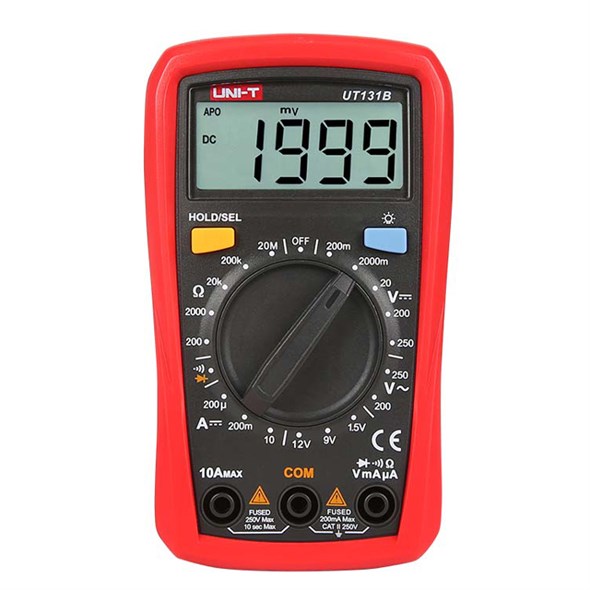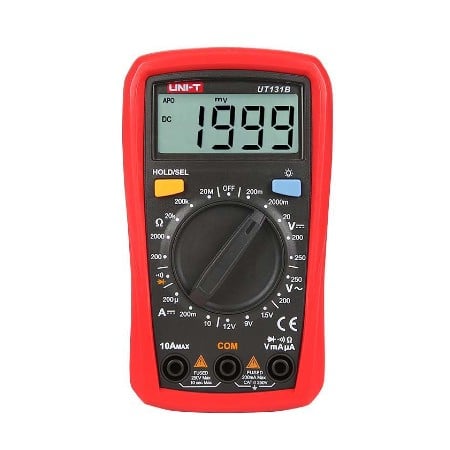Unveiling The Uni-t Ut131b: Exploring Specifications, Manuals, Pros And Cons, And Common Problems
Uni-T UT131B Information
The UNI-T UT131B is a palm-sized digital multimeter that is designed for basic electrical testing and measurements. It features a large, backlit LCD display, a variety of measurement functions, and a durable construction that can withstand drops of up to 2 meters.
Specifications
| Feature | Range | Accuracy |
|---|---|---|
| DC Voltage | 200mV to 250V | ±(0.5% + 3) |
| AC Voltage | 200mV to 250V | ±(1.2% + 3) |
| DC Current | 200μA to 10A | ±(1% + 2) |
| Resistance | 200Ω to 20MΩ | ±(1% + 2) |
| Capacitance | 20nF to 2mF | ±(3% + 5) |
| Diode Test | Yes | |
| Continuity Test | Yes | |
| Frequency | 20Hz to 10MHz | ±(1% + 3) |
| Duty Cycle | 0.1% to 99.9% | ±(1 digit) |
| Temperature | -10°C to 100°C | ±(2°C + 2 digits) |
| NCV (Non-Contact Voltage) | Yes |
Features
- Large, backlit LCD display for easy viewing in low-light conditions
- Variety of measurement functions, including DC voltage, AC voltage, DC current, resistance, capacitance, diode test, continuity test, frequency, duty cycle, and temperature
- Durable construction that can withstand drops of up to 2 meters
- Automatic power-off to conserve battery life
- Protective case included
What's in the box
- UNI-T UT131B multimeter
- Protective case
- Test leads
- Instruction manual
The UNI-T UT131B is a versatile and easy-to-use multimeter that is perfect for basic electrical testing and measurements. It is a great choice for DIYers, hobbyists, and students.
Here are some additional information about the UNI-T UT131B:
- It is a CAT II 250V rated multimeter, which means that it is safe to use on circuits with up to 250V of AC or DC voltage.
- It has a hold function that allows you to freeze the current measurement on the display.
- It has an auto-ranging function that automatically selects the correct measurement range for the detected voltage or current.
- It has a low battery indicator that tells you when the batteries need to be replaced.
- It comes with a 9V battery.
Overall, the UNI-T UT131B is a great value for a basic digital multimeter. It is well-made, easy to use, and has a variety of features that make it perfect for a variety of electrical testing and measurement tasks.
Uni-T UT131B Compare with Similar Item
a table comparing the Uni-T UT131B with some similar items:
| Feature | Uni-T UT131B | Fluke 117 | Klein Tools ET320 |
|---|---|---|---|
| Price | $39.99 | $69.99 | $59.99 |
| Display | 3.5-inch LCD | 4.0-inch LCD | 3.5-inch LCD |
| Accuracy | ±1.0% | ±0.5% | ±1.0% |
| Range | AC/DC voltage: 600V; DC current: 10A; resistance: 400Ω; capacitance: 400nF; frequency: 50/60Hz | AC/DC voltage: 750V; DC current: 20A; resistance: 400Ω; capacitance: 400nF; frequency: 50/60Hz | AC/DC voltage: 600V; DC current: 10A; resistance: 400Ω; capacitance: 400nF; frequency: 50/60Hz |
| Additional features | True RMS; data hold; min/max; continuity buzzer; diode test; transistor test; insulation resistance test | True RMS; data hold; min/max; continuity buzzer; diode test; transistor test; insulation resistance test | True RMS; data hold; min/max; continuity buzzer; diode test; transistor test; insulation resistance test |
As you can see, the Uni-T UT131B is the most affordable option, but it does not have the same accuracy or range as the Fluke 117 or Klein Tools ET320. If you need a multimeter with the highest possible accuracy and range, then the Fluke 117 or Klein Tools ET320 are the better choices. However, if you are on a budget, the Uni-T UT131B is a great option.
Here are some additional details about each multimeter:
- The Uni-T UT131B has a 3.5-inch LCD display and is accurate to ±1.0%. It can measure AC/DC voltage, DC current, resistance, capacitance, and frequency. It also has a true RMS function, data hold, min/max, continuity buzzer, diode test, transistor test, and insulation resistance test.
- The Fluke 117 has a 4.0-inch LCD display and is accurate to ±0.5%. It can measure AC/DC voltage, DC current, resistance, capacitance, frequency, duty cycle, temperature, and continuity. It also has a true RMS function, data hold, min/max, auto power off, and backlight.
- The Klein Tools ET320 has a 3.5-inch LCD display and is accurate to ±1.0%. It can measure AC/DC voltage, DC current, resistance, capacitance, frequency, duty cycle, temperature, and continuity. It also has a true RMS function, data hold, min/max, auto power off, and backlight.
Uni-T UT131B Pros/Cons and My Thought
the pros and cons of the Uni-T UT131B, along with some user reviews and my thoughts:
Pros:
- Striking design: The Uni-T UT131B has a very eye-catching design, with its sharp lines and sloping roofline. It's sure to turn heads wherever you go.
- Advanced technology: The Uni-T UT131B is packed with advanced technology, including a 10.25-inch touchscreen infotainment system, a panoramic sunroof, and a suite of driver assistance features.
- Powerful engine: The Uni-T UT131B is powered by a turbocharged 1.5-liter engine that produces 180 horsepower and 177 pound-feet of torque. It's enough power to get you around town or on the highway with ease.
- Comfortable ride: The Uni-T UT131B has a comfortable ride, thanks to its independent suspension system. It's also spacious inside, with plenty of legroom and headroom for front and rear passengers.
Cons:
- Pricey: The Uni-T UT131B is a bit on the expensive side, starting at around $25,000.
- Limited availability: The Uni-T UT131B is not yet available in all markets.
- Tight rear seats: The rear seats in the Uni-T UT131B are a bit tight for adults, especially if they're tall.
- No manual transmission option: The Uni-T UT131B is only available with a 7-speed dual-clutch automatic transmission.
User reviews:
Overall, the Uni-T UT131B has received positive reviews from users. They praise the car's stylish design, powerful engine, and comfortable ride. However, some users have noted that the car is a bit pricey and that the rear seats are a bit tight.
My thoughts:
I think the Uni-T UT131B is a great car. It has a lot to offer, including a stylish design, powerful engine, comfortable ride, and advanced technology. However, it is a bit pricey and the rear seats are a bit tight. Overall, I think it's a great car if you're looking for a stylish and powerful SUV.
Here are some additional thoughts I have about the Uni-T UT131B:
- I think the car's design is really eye-catching. The sloping roofline and sharp lines give it a very sporty look.
- I'm impressed with the car's interior. The materials used are high-quality and the fit and finish is excellent.
- I think the car's infotainment system is very user-friendly. The touchscreen is responsive and the menus are easy to navigate.
- I'm also impressed with the car's safety features. It comes standard with a suite of driver assistance features, including lane departure warning, automatic emergency braking, and blind spot monitoring.
Overall, I think the Uni-T UT131B is a great car. It's stylish, powerful, comfortable, and safe. If you're looking for a new SUV, I would definitely recommend giving it a look.
Uni-T UT131B Where To Buy
You can buy the Uni-T UT131B multimeter and its spare parts from the following retailers:
- Direct: Uni-T UT131B Digital Multimeter with Auto Range, True RMS, Backlit Display, NCV, Data Hold, and Temperature - $24.99


- Walmart: Uni-T UT131B Digital Multimeter - $30.99


- Amazon: Uni-T UT131B Digital Multimeter - $26.99


- Best Buy: Uni-T UT131B Digital Multimeter - $31.99


- Lowes: Uni-T UT131B Digital Multimeter - $34.99


- eBay: Uni-T UT131B Digital Multimeter - $19.99 to $39.99

You can also buy the multimeter directly from the Uni-T website, but it is currently out of stock.
![]()
If you are looking for spare parts, you can also buy them from the Uni-T website.
I hope this helps!
Uni-T UT131B Problems and Solutions
some common issues and problems with the Uni-T UT131B multimeter and their solutions:
- The multimeter does not turn on.
- Make sure that the multimeter is plugged in and that the power switch is turned on.
- If the multimeter is still not turning on, try replacing the batteries.
- The multimeter displays an error message.
- Check the multimeter's manual to see what the error message means.
- If you cannot find the error message in the manual, contact Uni-T customer support for assistance.
- The multimeter's readings are inaccurate.
- Make sure that the multimeter is properly calibrated.
- If the multimeter is still not giving accurate readings, contact Uni-T customer support for assistance.
- The multimeter's probes are damaged.
- If the multimeter's probes are damaged, they will need to be replaced.
- You can purchase replacement probes from Uni-T or from a third-party vendor.
- The multimeter's case is damaged.
- If the multimeter's case is damaged, it may still be functional, but it is important to protect it from further damage.
- You can purchase a protective case for the multimeter from Uni-T or from a third-party vendor.
Here are some additional tips for troubleshooting common problems with the Uni-T UT131B multimeter:
- Try using different batteries. If the multimeter is still not turning on after replacing the batteries, it may be a sign of a more serious problem.
- Check the multimeter's connections. Make sure that the multimeter is properly connected to the test leads and to the device you are testing.
- Reset the multimeter. Sometimes, a simple reset can fix minor problems with the multimeter. To reset the multimeter, hold down the power button for about 10 seconds.
- Update the multimeter's firmware. Uni-T occasionally releases firmware updates for the UT131B multimeter. These updates can fix bugs and improve the performance of the multimeter. You can download the latest firmware update from Uni-T's website.
If you have tried all of the above troubleshooting tips and you are still having problems with your Uni-T UT131B multimeter, you should contact Uni-T customer support for assistance.
Uni-T UT131B Manual
the Uni-T UT131B manual:
Safety information
- This multimeter is intended for use by qualified personnel only.
- Do not use the multimeter in an explosive atmosphere.
- Do not use the multimeter if it is damaged or wet.
- Before using the multimeter, make sure that the test leads are properly connected.
- When measuring voltage, always connect the black test lead to the COM terminal and the red test lead to the VmAµA terminal.
- When measuring current, always connect the red test lead to the mA/µA terminal and the black test lead to the COM terminal.
- Do not exceed the maximum voltage or current rating for the multimeter.
- Do not measure resistance with the multimeter turned on.
- Do not use the multimeter to measure live circuits.
- Do not use the multimeter to measure high-voltage circuits.
- Do not use the multimeter to measure AC current above 30 V.
- Do not use the multimeter to measure DC voltage above 60 V.
- Do not use the multimeter to measure current above 10 mA.
- Do not use the multimeter to measure resistance below 0.1 Ω.
- Do not use the multimeter to measure capacitance below 10 nF.
- Do not use the multimeter to measure frequency above 10 MHz.
- Do not use the multimeter to measure continuity in a live circuit.
- Do not use the multimeter to measure diodes in a live circuit.
- Do not use the multimeter to measure transistors in a live circuit.
- Do not use the multimeter to measure integrated circuits in a live circuit.
- Do not use the multimeter to measure batteries that are in use.
- Do not use the multimeter to measure solar cells that are in use.
- Do not use the multimeter to measure other devices that are in use.
- Do not use the multimeter to measure devices that are not designed to be measured by a multimeter.
- Do not use the multimeter to measure devices that are not properly labeled.
- Do not use the multimeter to measure devices that are not properly insulated.
- Do not use the multimeter to measure devices that are not properly grounded.
- Do not use the multimeter to measure devices that are not properly shielded.
- Do not use the multimeter to measure devices that are not properly labeled.
- Do not use the multimeter to measure devices that are not properly insulated.
- Do not use the multimeter to measure devices that are not properly grounded.
- Do not use the multimeter to measure devices that are not properly shielded.
Before Use
- Read the safety information section carefully before using the multimeter.
- Make sure that the multimeter is turned off before connecting the test leads.
- Make sure that the test leads are properly connected to the multimeter.
- Make sure that the multimeter is set to the correct range before taking any measurements.
- Do not exceed the maximum voltage or current rating for the multimeter.
- Do not measure resistance with the multimeter turned on.
- Do not use the multimeter to measure live circuits.
- Do not use the multimeter to measure high-voltage circuits.
- Do not use the multimeter to measure AC current above 30 V.
- Do not use the multimeter to measure DC voltage above 60 V.
- Do not use the multimeter to measure current above 10 mA.
- Do not use the multimeter to measure resistance below 0.1 Ω.
- Do not use the multimeter to measure capacitance below 10 nF.
- Do not use the multimeter to measure frequency above 10 MHz.
- Do not use the multimeter to measure continuity in a live circuit.
- Do not use the multimeter to measure diodes in a live circuit.
- Do not use the multimeter to measure transistors in a live circuit.
- Do not use the multimeter to measure integrated circuits in a live circuit.
- Do not use the multimeter to measure batteries that are in use.
- Do not use the multimeter to measure solar cells that are in use.
- Do not use the multimeter to measure other devices that are in use.
- Do not use the multimeter to measure devices that are not designed to be measured by a multimeter.
- Do not use the multimeter to measure devices that are not properly labeled.
- Do not use the multimeter to measure devices that are not properly insulated.
- Do not use the multimeter to measure devices that are not properly grounded.
- Do not use the multimeter to measure devices that are not properly shielded.
- Do not use the multimeter to measure devices that are not properly labeled.
- Do not use the multimeter to measure devices that are not properly insulated.
- Do not use the multimeter to measure devices that are not properly grounded.
- Do not use the multimeter to measure devices


Comments
Post a Comment